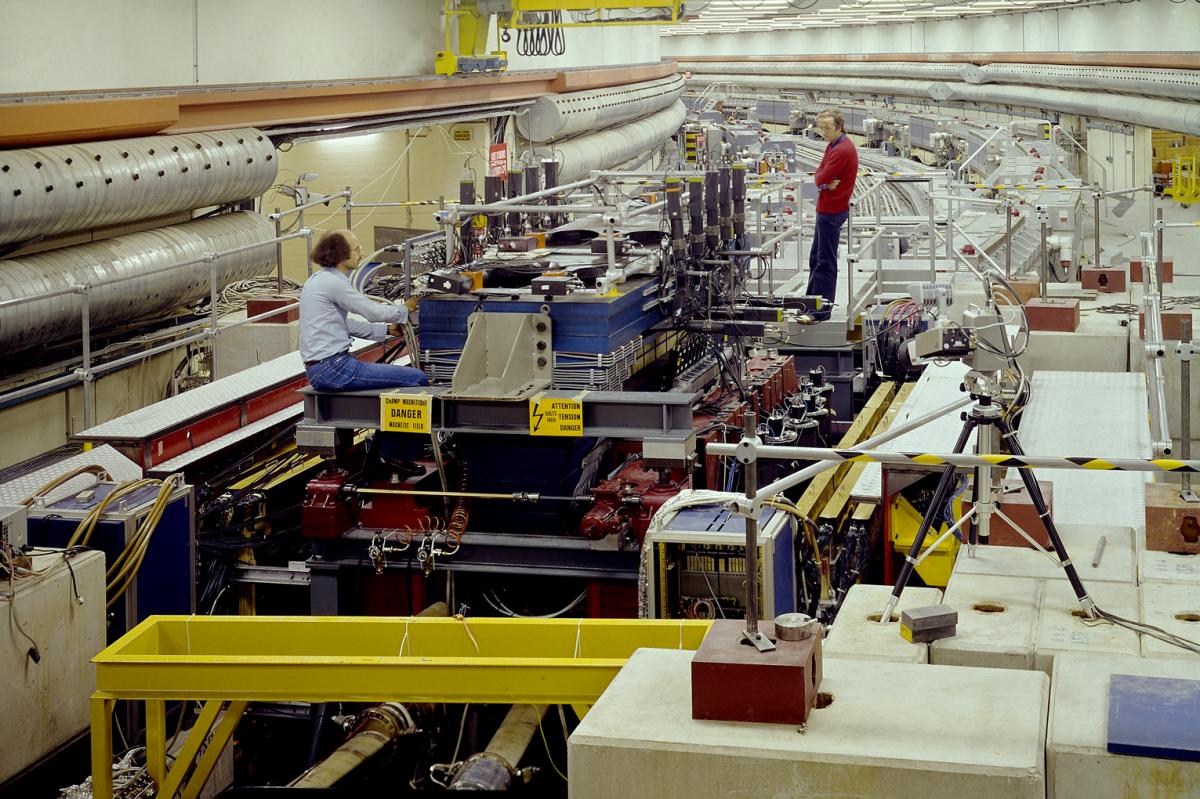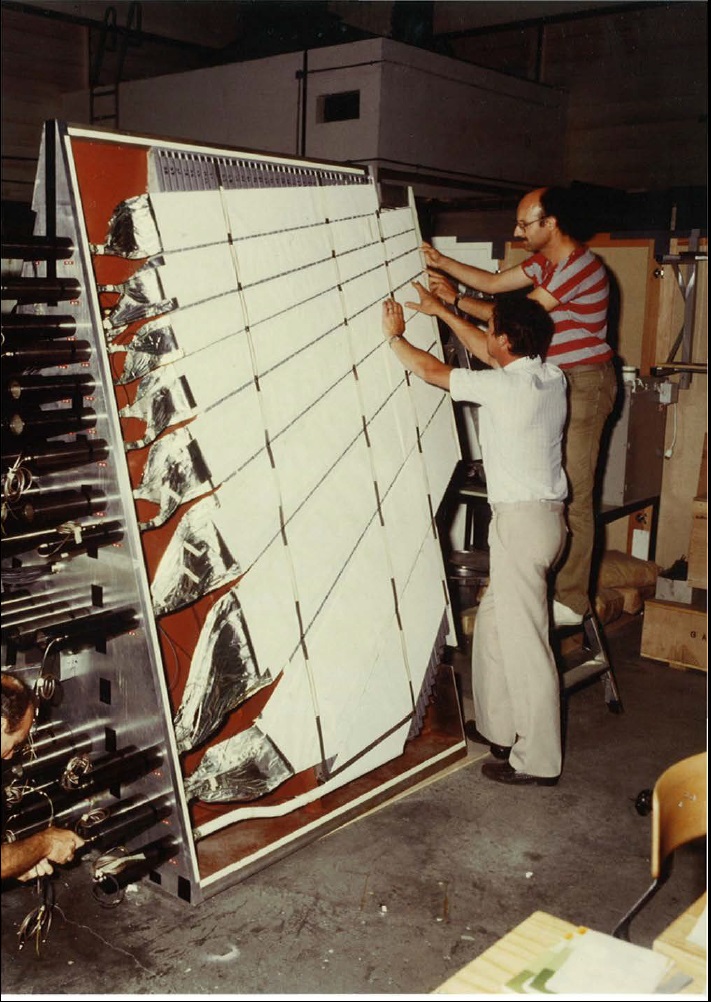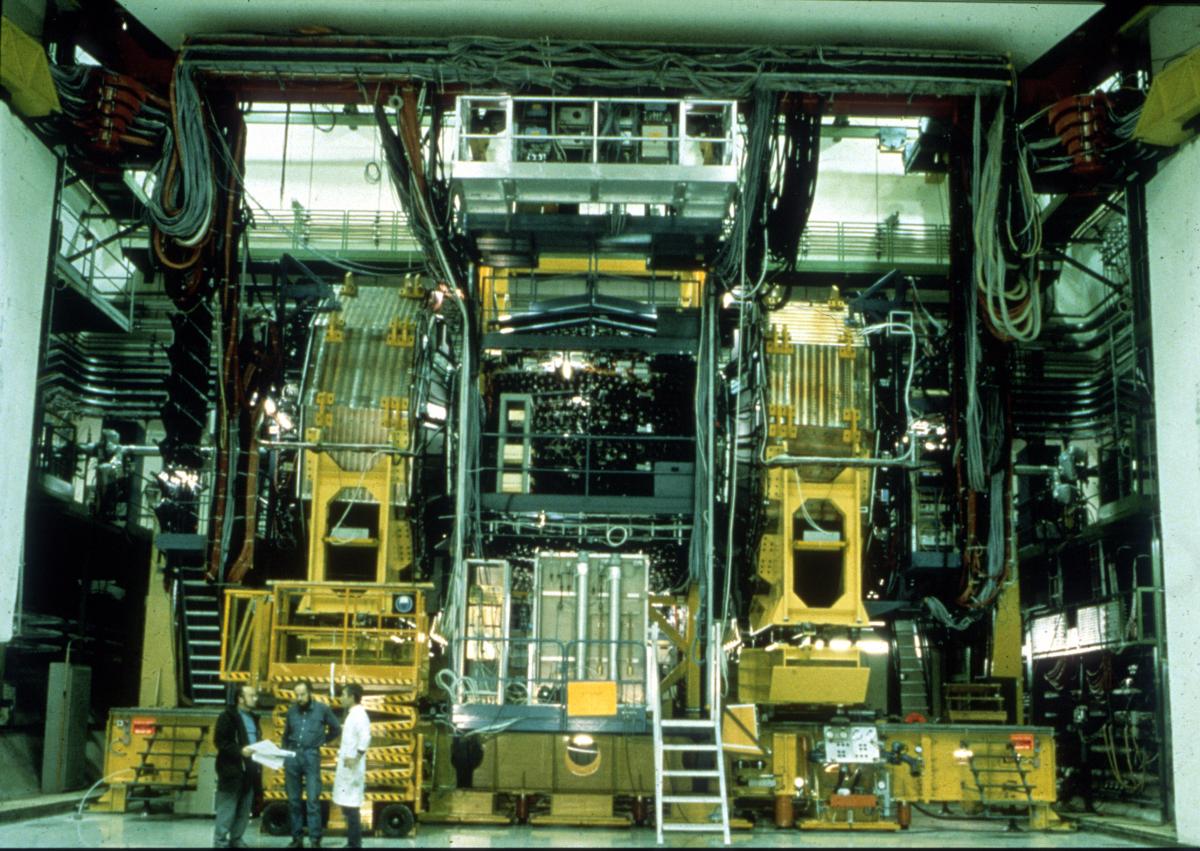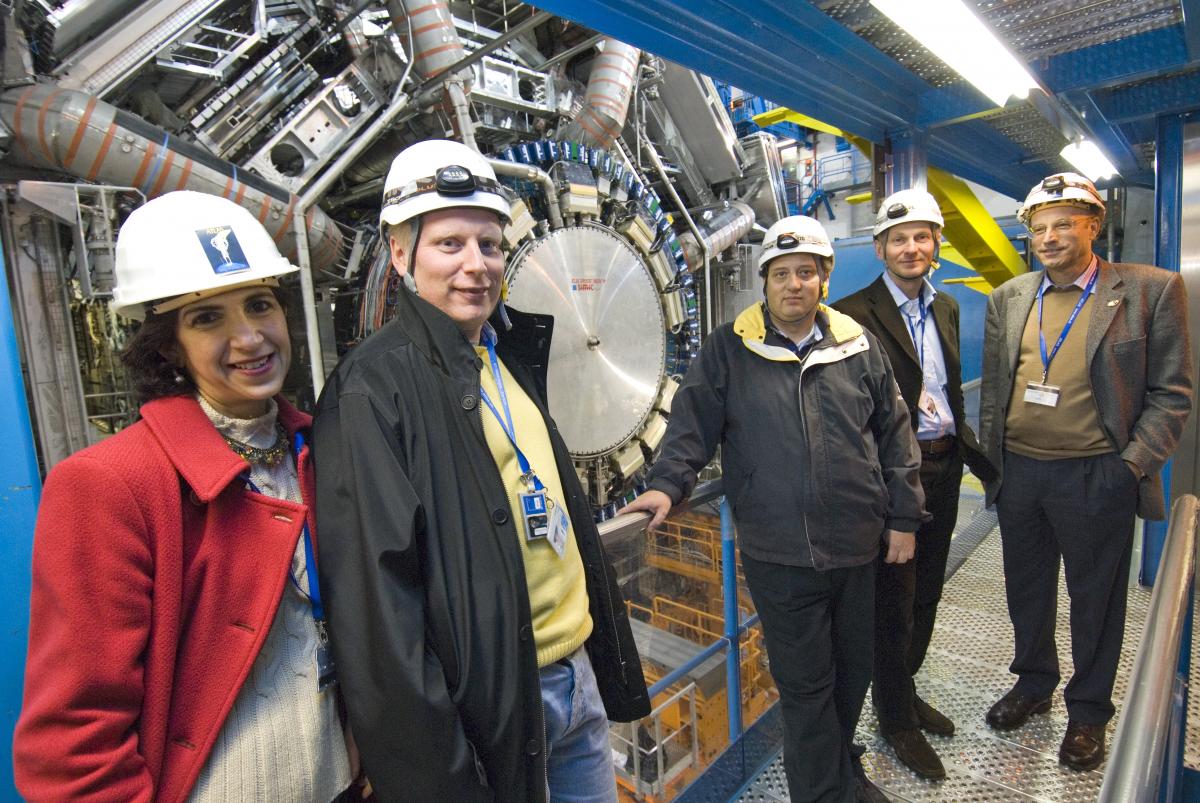Interview with Peter Jenni
Peter Jenni's interest in physics began in a very young age. He had always enjoyed reading about physics although his high-school physics teacher wasn’t very inspiring as an educator. Studying Physics seemed as a natural choice, hence he decided to focus on experimental physics as well as astronomy and mathematics. He obtained his first physics degree at the University of Bern, and later undertook doctoral studies at the ETH Zurich. If he hadn’t become a physicist he might have pursued a career as a chess-player as he used to spend a lot of time with the Swiss junior team. However, he made the right choice, as one can realize by looking at his CV and his hundreds of publications in physics.
Following a long career at CERN that dates back to 1970 (ranging from Summer Student to Fellow and to Staff), Peter has recently retired after about 40 years marked by exciting discoveries (first two-photon production of eta-prime at SPEAR, SLAC, first hint for open charm at the ISR, jets, W and Z at the SPS ppbar Collider, Higgs boson at LHC). Peter was involved in the LHC from the beginning and was spokesperson of the ATLAS Collaboration until February 2009. The discovery of the Higgs boson has been one of his most rewarding moments and he received a share of the Special Fundamental Physics Prize for the leadership leading to this discovery, earlier in March. Last month, the 2013 EPS HEPP Prize was awarded to Peter Jenni jointly with Michel Della Negra and Tejinder Virdee for their pioneering work in setting up the ATLAS and CMS experiments, and to the ATLAS and the CMS collaborations.
Peter Jenni will continue working with ATLAS as a guest scientist with the Albert-Ludwigs-University Freiburg, and he still spends most of his time in his office in Building 40 where we met.
P.C. When did you first arrive to CERN?
P.J. I first came to CERN as a Summer Student in the very early 70s, following a period during which I was working as a member of the University of Bern Group for my diploma thesis on an experiment at the SC. It was an experiment that produced muonium atoms in a magnetic bottle. Later, I returned as a Fellow in the group of Massimiliano Ferro-Luzzi working on my PhD thesis, which I finally defended at ETH Zurich in 1976.
My thesis focused on very small angle elastic scattering in the Coulomb-nuclear interference region. We were looking at the scattering amplitude and its real part and applied the results in dispersion relations, predicting the cross sections at very high energies. At this point, I started getting interested in high energy physics.
I was motivated to come as a Fellow by Charles Peyrou, the division leader of the TC department and a guest professor at the University of Bern. I was often the only student in the lectures that he used to deliver on Saturday morning at the University of Bern.
After finishing my PhD I joined the ETH Zurich group working in the ISR (R702) experiment. The spokesperson was Pierre Darriulat and there I also met Burton Richter who at that time was on a sabbatical from SLAC. He was interested in studying electron-muon coincidences as a first signature of open charm production. Therefore the Zurich group built a small muon spectrometer with the help of CERN to complement the electron arms of R702. At that time, the J/ψ was known but an open-charm quark had not been observed yet. Hence, the idea was to look for open-charm since, when a charm-anticharm quark pair is produced, an electron -muon pair can appears sometimes in the decay chain giving a unique signature.

Peter Jenni (in front) working with Hans Falk Hoffmann in building a small muon spectrometer for the ISR (R702) experiment: August 1977.
P.C. You also spent a few years working at SLAC. What did you work on at that time?
P.J. Following my work on the e μ analysis I moved with Burton Richter to SLAC. In 1978-1979 I was a research associate at SLAC, working in the MARK II experiment. Together with a Russian colleague (Valery Telnov) also a postdoc we published the first paper on MARK II, namely “the two photons production of the η prime”. Until then, two photons physics was considered to be merely a background to "the real" physics; However the measurement of the two-photon widths in η prime was giving further direct support to the quark model.
Moreover, my time at SLAC was very interesting because, for the first time, I gained considerable experience of electron-positron colliders while I also had the chance to work with a liquid-argon calorimeter that was installed in MARK II. Altogether, I think that my experience of the calorimeter of MARK II played an important role later in my career.
P.C. When did you start working in the UA2 experiment?
I had worked in the past with Pierre Darriulat at the ISR. Even before leaving CERN it was clear that I would return to work with his group and more specifically with the calorimeter of the UA2 experiment. During that period I gained valuable with hardware and my collaborators knew me for testing and calibrating the UA2 calorimeters. For example, I met the Japanese groups working in OPAL, making some calibrations of lead-glass blocks; thanks to these connections the Japanese groups joined ATLAS later.
In addition, I had the opportunity to collaborate with a number of brilliant postdocs, when they were students at SLAC. Many of them came to CERN later to work in the UA2 experiment and at the ISR. Among them was Tom Himel who is now well-known in the electron-positron world and Jim Siegrist, who is now the Associate Director at DOE’s Office of High Energy Physics. Jim and I were particularly looking for jets in UA2, which proved to be one of the first highlights of the experiment, due to the different approach that we adopted in looking for jets. Until that time, people were looking for leading π0 –mainly at the ISR- but we decided to look for the energy flow pattern exploiting the UA2 design with its highly segmented calorimeter.

Peter Jenni (in the back) is closely checking the last details of an end-cap calorimeter module for the upgrade of the UA2 experiment: July 1985.
Finally, the co-discovery and mass measurements of the W and Z vector bosons with UA2 have been an important milestone. More particularly, the high precision achieved with UA2 thanks to the design of the calorimeters and the many years of hard calibration work has been one of the greatest moments of my entire career.
P.C. How long did you work on the UA2 experiment?
P.J. More than a decade. UA2 went through an upgrade phase, during which I was responsible for the new end-cap calorimeter, as initially UA2 had only electromagnetic calorimeters in that region. Thus, we had to rebuild in a novel but also complicated way the forward calorimeters for the experiment. The main motivation behind this development was the search for supersymmetry, which also played an important role later, in the design of the ATLAS experiment.
For the upgrade of UA2 we had to invent the analysis and triggers on supersymmetry. At this point, I met Fabiola Gianotti. She joined the experiment as a PhD student, carrying out intensive hardware and analysis work for her SUSY thesis and we have been closely working ever since.
Reflecting on the UA1 and UA2 experiments, I think they were both important not only because of the exciting scientific discoveries but because they proved that discoveries can be made at hadron colliders. There was no doubt that the Z and W did stand out very clearly from the background, but, until then, many were sceptical about the potential of hadron collisions.
It was thought that there are too many debris from the normal interactions, thus new physics is impossible. It was widely supported that new physics occurs only in a clean e+e- environment, but the discoveries from UA1 and UA2 paved the way for a new generation of experiments.

UA2 upgraded experiment with end-caps. A quite novel approach was used in building these calorimeters: October 1987.
P.C. It sounds that UA1 and UA2 opened new directions in HEP. Was it during that time that the idea of building a Large Hadron Collider for pp collisions emerged?
P.J. During the first phase of the SPS ppbar Collider it became clear that the LEP tunnel –which was not built yet - could eventually house a Large Hadron Collider that would probe the TeV energy scale. Thankfully, Herwig Schopper who was CERN DG at that time decided to build the LEP tunnel with a cross-section big enough for the LHC. It should be noted that discussions for a Large Hadron Collider were already taking place in the late 1970s.
The enthusiasm for building a Large Hadron Collider at CERN was expressed during a workshop that was organized in Lausanne in 1984 by the European Committee for Future Accelerators (ECFA) and CERN. It was the first workshop on a “Large Hadron Collider in the LEP tunnel” that brought together theorists, experimentalists and accelerator experts. There were five or six working groups and I was the convenor for the working group on “jet calorimetry”. That was a promising start which marked the end of the first phase of the UA experiments. In a series of workshops we discussed the potential for new discoveries in the following years and the physics that could be explored, as well as the experimental challenges.
The next important workshop took place in 1987 in La Thuile for the so-called “Rubbia Long-Range Planning Committee”. During the workshop, where I was one of the organizers, we evaluated the potential of a large electron-positron collider (already named CLIC) and of a Large Hadron Collider. Carlo supported the LHC project and in the early 90s the Council decided that CERN should follow this direction. A proposal for the machine was formulated and it was finally submitted in 1993 when Chris Llewellyn Smith was the DG of CERN.
P.C. What were the main scientific questions that HEP was trying to address at that time?
P.J. Clearly one of the main major aims was the discovery of the Higgs particle. At that time, there was no clear indication for the Higgs mass yet. As you probably know, the mass of the Higgs is not predicted by theory and it could be as high as 1 TeV. We had to have a design that could detect both a high-mass and a low-mass Higgs. This required a search over a broad range of mass that would suit an exploratory machine like a proton-proton collider. As the energy carried by the protons is distributed among its constituent partons, it allows the entire range of masses to be scanned at the same time. The production mechanism for the Higgs boson involves the combination of these subnuclear particles as well as force carriers. Later the LEP results indicated a low mass Higgs (of 114<m<150 GeV) but we did not know that when the first discussions about the LHC started.
Moreover, a second motivation has always been the search for supersymmetry. Of course supersymmetry became very popular later, as it is possibly connected to dark matter. But in the early years nobody, at least to my knowledge, was considering this connection. However, there were many ideas about heavy W or Z primes. We were also very interested in quark compositeness which requires the measurement of jets at very high pT. The searches for supersymmetry, quark compositeness and heavy-resonances decaying into gluons and quarks demanded good hadron calorimetry. Consequently the construction of a calorimeter that would be free from magnetic field constraints, as it was possible in a toroid configuration, was considered necessary. Of course, another constraint is that physics in a hadron collider is flat in rapidity therefore it’s natural to have more bending power in the forward direction in order to achieve the same resolution in the pT. These were important reasons why in the design of the experiment we decided to have a toroid rather than a solenoid.
P.C. How did the ATLAS collaboration start? When was the idea for a general purpose experiment formed?
P.J. In a workshop organized by ECFA in 1989 in Barcelona during which me and some colleagues formed a proto-collaboration as we thought that we should ensure having coherent R&D for the different layers of the detector (i.e. muon detector, hadron calorimeter, EM calorimeter, tracking). In addition, we discussed data acquisition and the trigger during that workshop.
CERN realized that we are moving quite fast and another very important workshop was organized in Aachen in 1990. We held detailed discussions in order to decide which detector technologies and magnetic field configurations to deploy. After the workshop the Detector Research and Development Committee (DRDC) was formed to peer review and monitor R&D proposals. For example, there was RD1 for scintillator-fiber calorimeter, RD2 for silicon tracking, RD3 was for the ‘accordion’ calorimeter, RD5 was looking for the detection of muons and many others followed; including triggering, DAQ and computing.
In March 1992, the famous conference “Towards the LHC Experimental Programme” took place in Evian-les-Bains, where several protocollaborations presented their designs in “Expressions of interest”. The two designs deploying toroidal configurations merged to form the ATLAS experiment, selecting finally a superconducting aircore toroid for the measurement of muons, supplemented by a superconducting 2T solenoid to provide the magnetic field for inner tracking and using a liquid-argon/lead electromagnetic calorimeter with a novel “accordion” geometry and an innovative scintillator tile hadron calorimeter. The deadline for the Letter of Intent (LoI) was October 1st 1992 when the name ATLAS appeared for the first time in an official document. It was clear that the resources would permit the building of only two general-purpose experiments. It took seven rounds of intense encounters between the experiment teams and the LHCC referees before the committee decided at its 7th meeting on 8-9 June 1993 “to recommend provisionally that ATLAS and CMS should proceed to technical proposals”.
P.C. You had been the ATLAS spokesperson until February 2009. How would you describe that time and the challenges that you faced?
P.J. Over this long time there have been many challenges as these were bigger experiments than ever done, involving many groups around the world, but also much more expensive than past ones. As a consequence we had to be more formal and establish certain procedures that had to be followed. At the same time we allowed for some flexibility essentiall for a scientist, be them physicists working on their analysis or an engineer building a new part of a detector. Achieving the correct balance between these two was a real challenge. Hence, we tried to put the right structures in the organization of the collaboration from the very beginning and create an effective administrative structure. Meanwhile, we placed special emphasis on receiving input from everybody by holding many plenary meetings where every member of the collaboration had the opportunity to voice their ideas and concerns.
The ATLAS collaboration grew rapidly, in terms of people and institutes, following the submission of the LoI. Finding new collaborators was a high priority as we needed many resources, both human and material in order to design and build the experiment. We always kept an eye on material contributions as well as intellectual ones from the various countries. It was very important and difficult to assure the financing needed, and that’s something people now tend to forget. ATLAS is a very expensive experiment. You could only find the necessary resources when the community from a given country actually wanted to build some parts of the detector. Considerable effort was made to welcome openly non-member state groups on board.
P.C. Acting as the ATLAS spokesperson for nearly 15 years I am sure that you had many important moments. However, I wonder whether there are some difficult moments that you can recall.
P.J. There were certainly interesting and challenging moments. At the end of the day, when you face big difficulties as a spokesperson, you are alone. Of course you have friends and people with whom you can discuss but there is always a moment that you feel alone. I remember that a former Director-General said that if the experiment does not perform properly and we should fire someone, first it will be the spokesperson and I thought that I should stay until the experiment is running smoothly, so that no one else gets wasted and fired in case of a problem.
Naturally, there are many things that could go wrong in a detector (i.e. the failure of the cooling or the magnets) and sometimes I think that people do not realize what the smooth functioning of the experiment means. They often take for granted that the experiment works, often forgetting about the complications, and that something could actually go wrong. For me sometimes it looks like a small miracle that all is working so well in general.

The ATLAS management team in the experimental cavern: From Left to Right: Fabiola Gianotti, Markus Nordberg, Marzio Nessi, Steinar Stapnes and Peter Jenni: March 2007.
P.C. What were the nicest experiences that you had as the ATLAS Spokesperson? What did you get from this position?
P.J. First, I should mention the great management team and the nice communication that we had. Working with them has always been a pleasure for me. More particularly, I would like to mention the deputy spokespersons Fabiola Gianotti and Steinar Stapnes, and the Technical and Resources Coordinators Marzio Nessi and Markus Nordberg, and then the many sub-system project leaders and activity coordinators over the years. I think that the spirit of collaboration, which we cultivated in general among the members of our collaboration, has been one of the main reasons behind our success. I always tried to encourage every single member to participate and I must say that I always felt very highly appreciated in the whole collaboration. I was moved to have a great party organized at end of February 2009 when I stepped down as a spokesperson. As I mentioned I still work closely with ATLAS and I am happy to consult sometimes the new management about their future steps.
P.C. W and Z bosons, low mass Higgs-like particle. Do you feel in a sense haunted by the SM? Do you think that there is still space for new physics?
We have a long way to go, and there is still room, for example, for supersymmetry. It’s clear that we need something more than the SM. As I already mentioned, my involvement in the UA2 upgrade for the search of supersymmetry has been one of the main motivations in designing the ATLAS experiment, so I don’t feel haunted by the SM at all. I think that supersymmetry might still be ahead, as might be other surprises. The LHC will only start exploring the high mass region in 2015 and with much more data we will be able to test more complicated scenarios. I think that many exotic things could be there and the LHC has still great potential in exploring new physics.
Moreover, we still need to explore whether it is “the” Higgs boson or “a” higgs boson. We know that it doesn’t decay like a normal particle and it has something to do with the electro-weak symmetry breaking and the mass mechanism that has been postulated almost 50 years ago. However, we could still have more than one Higgs particle, or the Higgs could also be a composite particle; all these are open research issues. All these things will be fully explored after the upgrade of the LHC. This has been a clear recommendation of the European Strategy for Particle Physics, for the elaboration of which I have enthusiastically contributed over the last year as a member of the Preparatory Group. I hope that CERN will take the strategy guidelines seriously.
Looking back, one can see that the LHC needed a long time to mature in the minds of people and then it took a long time to be approved by the Council and the funding agencies and the wider community. So we now have a fantastic opportunity that should be further exploited. The biggest reward is to see how enthusiastic and motivated young people are about physics. In order to guarantee that to future generations –including also those who are not yet born- we should seriously look to an “ambitious follow up project after the LHC at CERN”.
Happy faces after the discovery announcement of a new boson together with the CMS and ATLAS Spokespersons Joe Incandela (who had previously worked with Peter as a post-doc in the UA2 experiment) and Fabiola Gianotti: Melbourne July 2012
P.S. After so many years of scientific research what has changed regarding your personal attitude towards physics?
P.J Well, I have to admit that now I have the privilege of getting too many invitations to talk about physics, which gives me limited time for actually doing physics myself. I really admire people who go back after managerial duties and do their own research. I have not managed to do that, but I really enjoy talking with young people about their physics analyses.
Read here the French version of the full interview.
Further readings:
1. CERN Courier: June 2013, http://cerncourier.com/cws/article/cern/53423
2. http://www.sciencemag.org/content/338/6114/1558.full
3. M. Della Negra, P. Jenni, and T. S. Virdee, “Journey in the Search for the Higgs Boson:The ATLAS and CMS Experiments at the Large Hadron Collider”, Science 338 (2012) 1560-1568.
4. P. Grannis and P. Jenni, ‘The evolution of hadron-collider experiments’, Physics Today 66(6), 38 (2013).
